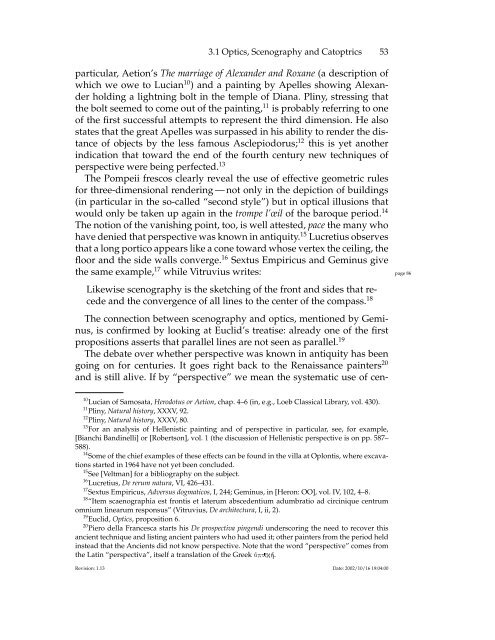1 The Birth of Science - MSRI
1 The Birth of Science - MSRI
1 The Birth of Science - MSRI
You also want an ePaper? Increase the reach of your titles
YUMPU automatically turns print PDFs into web optimized ePapers that Google loves.
3.1 Optics, Scenography and Catoptrics 53<br />
particular, Aetion’s <strong>The</strong> marriage <strong>of</strong> Alexander and Roxane (a description <strong>of</strong><br />
which we owe to Lucian 10 ) and a painting by Apelles showing Alexander<br />
holding a lightning bolt in the temple <strong>of</strong> Diana. Pliny, stressing that<br />
the bolt seemed to come out <strong>of</strong> the painting, 11 is probably referring to one<br />
<strong>of</strong> the first successful attempts to represent the third dimension. He also<br />
states that the great Apelles was surpassed in his ability to render the distance<br />
<strong>of</strong> objects by the less famous Asclepiodorus; 12 this is yet another<br />
indication that toward the end <strong>of</strong> the fourth century new techniques <strong>of</strong><br />
perspective were being perfected. 13<br />
<strong>The</strong> Pompeii frescos clearly reveal the use <strong>of</strong> effective geometric rules<br />
for three-dimensional rendering — not only in the depiction <strong>of</strong> buildings<br />
(in particular in the so-called “second style”) but in optical illusions that<br />
would only be taken up again in the trompe l’œil <strong>of</strong> the baroque period. 14<br />
<strong>The</strong> notion <strong>of</strong> the vanishing point, too, is well attested, pace the many who<br />
have denied that perspective was known in antiquity. 15 Lucretius observes<br />
that a long portico appears like a cone toward whose vertex the ceiling, the<br />
floor and the side walls converge. 16 Sextus Empiricus and Geminus give<br />
the same example, 17 while Vitruvius writes: page 86<br />
Likewise scenography is the sketching <strong>of</strong> the front and sides that recede<br />
and the convergence <strong>of</strong> all lines to the center <strong>of</strong> the compass. 18<br />
<strong>The</strong> connection between scenography and optics, mentioned by Geminus,<br />
is confirmed by looking at Euclid’s treatise: already one <strong>of</strong> the first<br />
propositions asserts that parallel lines are not seen as parallel. 19<br />
<strong>The</strong> debate over whether perspective was known in antiquity has been<br />
going on for centuries. It goes right back to the Renaissance painters 20<br />
and is still alive. If by “perspective” we mean the systematic use <strong>of</strong> cen-<br />
10 Lucian <strong>of</strong> Samosata, Herodotus or Aetion, chap. 4–6 (in, e.g., Loeb Classical Library, vol. 430).<br />
11 Pliny, Natural history, XXXV, 92.<br />
12 Pliny, Natural history, XXXV, 80.<br />
13 For an analysis <strong>of</strong> Hellenistic painting and <strong>of</strong> perspective in particular, see, for example,<br />
[Bianchi Bandinelli] or [Robertson], vol. 1 (the discussion <strong>of</strong> Hellenistic perspective is on pp. 587–<br />
588).<br />
14 Some <strong>of</strong> the chief examples <strong>of</strong> these effects can be found in the villa at Oplontis, where excava-<br />
tions started in 1964 have not yet been concluded.<br />
15 See [Veltman] for a bibliography on the subject.<br />
16 Lucretius, De rerum natura, VI, 426–431.<br />
17 Sextus Empiricus, Adversus dogmaticos, I, 244; Geminus, in [Heron: OO], vol. IV, 102, 4–8.<br />
18 “Item scaenographia est frontis et laterum abscedentium adumbratio ad circinique centrum<br />
omnium linearum responsus” (Vitruvius, De architectura, I, ii, 2).<br />
19 Euclid, Optics, proposition 6.<br />
20 Piero della Francesca starts his De prospectiva pingendi underscoring the need to recover this<br />
ancient technique and listing ancient painters who had used it; other painters from the period held<br />
instead that the Ancients did not know perspective. Note that the word “perspective” comes from<br />
the Latin “perspectiva”, itself a translation <strong>of</strong> the Greek .<br />
Revision: 1.13 Date: 2002/10/16 19:04:00










